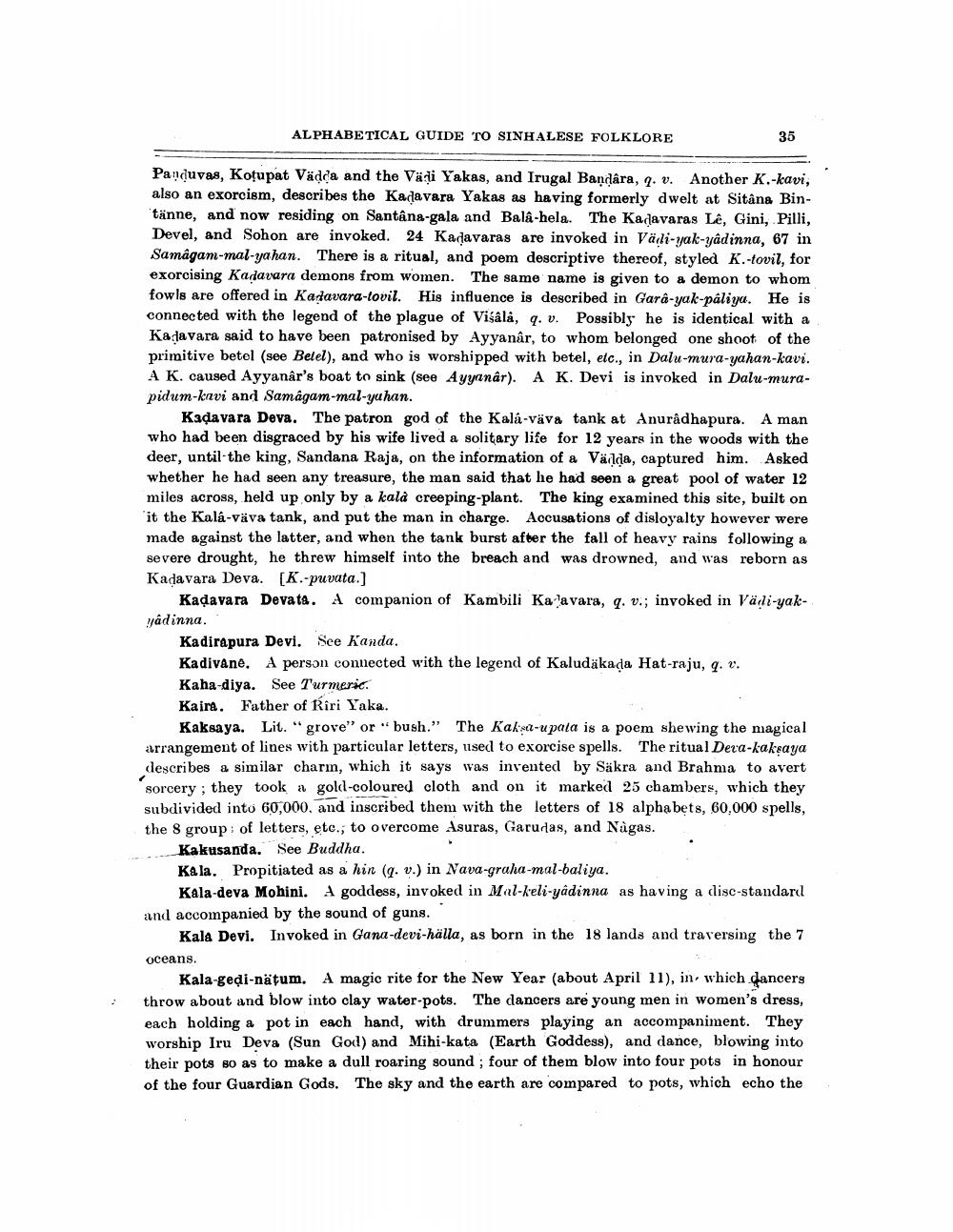________________
ALPHABETICAL GUIDE TO SINHALESE FOLKLORE
35
Panduvas, Kotupat Vädda and the Väļi Yakas, and Irugal Bandara, 2. v. Another K.-kavi, also an exorcism, describes the Kaclavara Yakas as having formerly dwelt at Sitâna Bintänne, and now residing on Santâna-gala and Balê-hela. The Kajavaras Lê, Gini, Pilli, Devel, and Sohon are invoked. 24 Kadavaras are invoked in Vädi-yak-yadinna, 67 in Samagam-mal-yahan. There is a ritual, and poem descriptive thereof, styled K.-tovil, for exorcising Kadavara demons from women. The same name is given to a demon to whom fowls are offered in Kanavara-lovil. His influence is described in Gara-yak-pâliyu. He is connected with the legend of the plague of Visâlâ, q.v. Possibly he is identical with a Ka Javara said to have been patronised by Ayyanâr, to whom belonged one shoot of the primitive betel (see Belel), and who is worshipped with betel, etc., in Dalu-mura-yahan-kavi. A K. caused Ayyanar's boat to sink (see Ayyanar). A K. Devi is invoked in Dalu-murapidum-knvi and Samagam-mal-yuhan.
Kadavara Deva. The patron god of the Kala-väva tank at Anuradhapura. A man who had been disgraced by his wife lived a solitary life for 12 years in the woods with the deer, until the king, Sandana Raja, on the information of a Vädda, captured him. Asked whether he had seen any treasure, the man said that he had seen a great pool of water 12 miles across, held up only by a kala creeping-plant. The king examined this site, built on 'it the Kalá-väva tank, and put the man in charge. Accusations of disloyalty however were made against the latter, and when the tank burst after the fall of heavy rains following a severe drought, he threw himself into the breach and was drowned, and was reborn as Kadavara Deva. (K.-puvata.)
Kadavara Devata. A companion of Kambili Ka avara, q. v.; invoked in Värli-yakyadinna.
Kadirapura Devi. See kanda. Kadivane. A person connected with the legend of Kaludäkada Hat-raju, q. v. Kaha-diya. See Turmeric. Kaina. Father of Riri Yaka.
Kaksaya. Lit. "grove" or "bush.” The Kake-upata is a poem shewing the magical arrangement of lines with particular letters, used to exorcise spells. The ritual Deva-kakşaya describes a similar charm, which it says was invented by Säkra and Brahma to avert sorcery; they took a gold-coloured cloth and on it marked 25 chambers, which they subdivided into 60,000, and inscribed them with the letters of 18 alphabets, 60,000 spells, the 8 group of letters, etc., to overcome Asuras, Garudas, and Nagas.
Kakusanda. See Buddha. Kala. Propitiated as a hin (q. v.) in Nava-graha-mal-baliya.
Kala-deva Mohini. Agoddess, invoked in Mal-keli-yadinna as having a disc-standard and accompanied by the sound of guns.
Kala Devi. Invoked in Gana-devi-hälla, as born in the 18 lands and traversing the 7 oceans.
Kala-gedi-nätum. A magic rite for the New Year (about April 11), in which dancers throw about and blow into clay water-pots. The dancers are young men in women's dress, each holding a pot in each hand, with drummers playing an accompaniment. They worship Iru Deva (Sun God) and Mihi-kata (Earth Goddess), and dance, blowing into their pots so as to make a dull roaring sound; four of them blow into four pots in honour of the four Guardian Gods. The sky and the earth are compared to pots, which echo the




